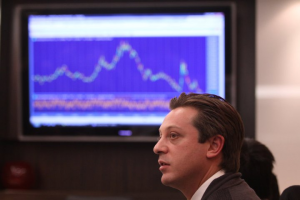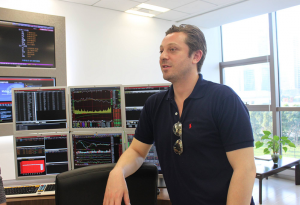 Soon the FxCuffs foundation will be hosting Mr. Anton Kreil as a key speaker of the FxCuffs Conference in Cracow, Poland. The event is planned as a two day conference and exhibition on 24-25th of March. Anton Kreil is a former Goldman Sachs, Lehman Brothers and JP Morgan trader who eventually left banking industry. In a series of controversial speeches he points out numerous problems with the banking sector these days. Today we are honored to present you his story told with his own words.
Soon the FxCuffs foundation will be hosting Mr. Anton Kreil as a key speaker of the FxCuffs Conference in Cracow, Poland. The event is planned as a two day conference and exhibition on 24-25th of March. Anton Kreil is a former Goldman Sachs, Lehman Brothers and JP Morgan trader who eventually left banking industry. In a series of controversial speeches he points out numerous problems with the banking sector these days. Today we are honored to present you his story told with his own words.
First part of the interview you can read here.
Marcin Nowogórski for FxCuffs [M.N.]
 Anton, hello again. I would like to thank you for a terrific interview you gave us last month, which brought many aspects of your past and current life to our readers’ attention. We received many comments to that interview, and people were very curious to dig deeper in some topics. To be honest, I’m very curious too. That’s why I have asked for this additional interview where I would like to present you some supplemental questions where many of them came from our readers.
Anton, hello again. I would like to thank you for a terrific interview you gave us last month, which brought many aspects of your past and current life to our readers’ attention. We received many comments to that interview, and people were very curious to dig deeper in some topics. To be honest, I’m very curious too. That’s why I have asked for this additional interview where I would like to present you some supplemental questions where many of them came from our readers.
M.N.
We know that you trade both Forex and Equities. How those two markets correspond with each other? Are there any differences in approach?
Anton Kreil [A.K]
Essentially correlation plays a big part. You simply cannot trade stocks successfully over the long term without having a fundamental grounding in understanding and trading FX. This is because if you are a truly good trader you do not limit yourself to opportunities. For example – saying “I only trade German stocks in the DAX” is a Retail grade approach and statement. Saying “I only trade U.S. small caps with one strategy” is also a Retail grade approach. Basically, one of the biggest mistakes Retail Traders make is limiting themselves to the “opportunities” in one asset class and / or one strategy. This means they have closed themselves off to all of the other potential opportunities in the World across all other asset classes.
We get a message through our website at least ten times per week. It is one of the most common questions we get sent to us. It goes something like this…, “I am a FOREX Day Trader. Can the Institutes education help me?” – Well what do you notice about this? The Trader has chosen to limit themselves to one asset class and one strategy. Why? Because they have been brainwashed into believing that this is how you make money in Financial Markets by people that have conflict of interest with their own goals. Their goal is to make money using their own money. The other person is always either a Broker or an Educator that gets paid by the Broker to peddle trading strategies that don’t work. This is so the Broker can take the other side of the trades and make money while they lose. It is very clear to us that the person making this statement has no formal education in trading provided to them by a Professional Trader. A Professional Trader would never ever limit themselves to one asset class and one time horizon. Think about it like this. If you claim to be a EUR/USD day trader, then what happens when EUR/USD does not move at all? Let’s say from this day now to 300 days from now it literally does not move and stays the same price every day and all day at the same price at 1.08. Can you make money from it? Of course, not. You would be buying and selling at the same price every day.
The point is simple yet so many people get it wrong all the time. You do not dictate to the market what the opportunities are. The market dictates them to you. Your job as a trader is to predict where the opportunities will be and to predict where the money will be made (or lost) in the future. The more opportunities you open yourself up to the more chance you have of being a consistently profitable trader over time. This is why I trade everything. Stocks, FOREX, Commodities, Bonds etc and Options within these asset classes., because you have to open yourself to the possibilities of making money everywhere so that if one asset class or area of an asset class fails to provide opportunities you can predict the opportunities elsewhere and stand the best chance of making money. There are only really about 16 FOREX pairs that are tradeable for Retail Traders. Meaning they have access to them via Retail Brokerage platforms. With stocks, there are 42,000 globally…, and on many larger Retail Brokerage platforms they are accessible.
With FOREX and Stocks, they are inherently correlated. So, you have to know how to trade both. If your trading account is denominated in EUR and you buy a US stock you buy it in USD. You have to buy the USD first then use the USD to purchase the USD denominated stock. This is done automatically for you by the Broker. If your stock goes up 10% but the USD goes down 10% when you unwind and trade back into EUR you have made no money. You are buying the EUR’s back up 10% from where you sold them. This is why correlation is important to Professional Traders. Professional Traders open themselves up to all opportunities globally. By doing so they must learn how to trade correlation successfully. This involves learning how to trade all asset classes and how they are linked. Anyone who makes the claim that a Professional Stock trader does not know how to trade FOREX only displays their own total lack of understanding on how Financial Market’s work.
In terms of approach, with FOREX it is all Macroeconomic drivers that you have to learn. You have to be a practical economist, not a theoretical one. I’m not talking about an approach where you know what the consensus is for a particular Macroeconomic number like the Non-Farm Payroll number and you buy and sell EUR/USD based on whether the number beats consensus or not. That’s again Retail Grade. You are reacting to what has already happened. Professional Traders predict the future and do not react to what has already happened. Also, the time horizon is much larger. In the current environment day traders in FOREX have been getting murdered for several years because the DAILY volatility of major FOREX pairs has been continually low. Whereas the guys that go for the big moves and have a 1-3 Month time horizon driven by predicting practical Macroeconomics i.e. a Professional approach have been the guys that always make money.
With stocks the approach is multi layered because it involves using both Macroeconomics which is essentially a Top Down analysis with Microeconomics and Finance which is a Bottom Up analysis. Combining both your view on FOREX pairs and Indexes gives you your Top Down View. Combining this with Bottom Up analysis i.e. looking at the Fundamentals that only affect a particular stock and its peers in an industry with a 1-3 Month time horizon allows you as a trader to open up to a lot more opportunities globally than any other trading approach I have ever seen. If you understand and are educated properly in how to do this, it works in all market dynamics. This is because it is a flexible approach.
M.N.
Do you trade CFDs or Forex spot? Do you think those instruments are appropriate for beginners? If no, then what is?
A.K.
 Yes, I trade CFDs all the time and they are absolutely fine for Retail Traders to trade. However, you have to understand how the risk and conflict of interest in trading them affects a Retail Trader approach. On most Brokerage Platforms, Retail Traders will receive 100X leverage in major FOREX Pairs. So, if you put $10,000 in your trading account you will be able to take $1,000,000 equivalent position in most FOREX pairs. Think about it like this. It doesn’t take a long time for anyone to open a trading account. Passport, Utility Bill, sign off a risk document with the Broker saying you understand the risks and you are happy to lose all your money. But why does the Broker give (lend) a person they have never met i.e. a total stranger 100 times what they deposit in their trading account for them to trade with? Simple. It’s because 90%+ of their clients lose money trading FOREX and they know that if they take the other side they will have a 90%-win ratio on all their trades. If you lose 1% on 100X leverage you are stopped out. This is ideal for the Broker. If they can convince everyone to trade in a way that makes them lose the Broker will always win. It’s a huge conflict of interest. The key is to realise this, understand it and to do the opposite of everything the Broker wants you to do. That involves setting your own risk limits and depositing a lot more in your trading account to cover any losses. Learn how to trade fundamentally, learn how to trade correlation and run portfolio’s and not day trade based only on low quality drivers that are essentially “Nosie” i.e. technicals. If as a beginner, you dive straight in and do everything the Broker or an Educator that works for a Broker tells you to do, you will always lose. If you are a beginner and you learn how to trade properly, CFD’s are totally fine as an instrument to make money.
Yes, I trade CFDs all the time and they are absolutely fine for Retail Traders to trade. However, you have to understand how the risk and conflict of interest in trading them affects a Retail Trader approach. On most Brokerage Platforms, Retail Traders will receive 100X leverage in major FOREX Pairs. So, if you put $10,000 in your trading account you will be able to take $1,000,000 equivalent position in most FOREX pairs. Think about it like this. It doesn’t take a long time for anyone to open a trading account. Passport, Utility Bill, sign off a risk document with the Broker saying you understand the risks and you are happy to lose all your money. But why does the Broker give (lend) a person they have never met i.e. a total stranger 100 times what they deposit in their trading account for them to trade with? Simple. It’s because 90%+ of their clients lose money trading FOREX and they know that if they take the other side they will have a 90%-win ratio on all their trades. If you lose 1% on 100X leverage you are stopped out. This is ideal for the Broker. If they can convince everyone to trade in a way that makes them lose the Broker will always win. It’s a huge conflict of interest. The key is to realise this, understand it and to do the opposite of everything the Broker wants you to do. That involves setting your own risk limits and depositing a lot more in your trading account to cover any losses. Learn how to trade fundamentally, learn how to trade correlation and run portfolio’s and not day trade based only on low quality drivers that are essentially “Nosie” i.e. technicals. If as a beginner, you dive straight in and do everything the Broker or an Educator that works for a Broker tells you to do, you will always lose. If you are a beginner and you learn how to trade properly, CFD’s are totally fine as an instrument to make money.
M.N.
How do you get access to the market? Previously you have mentioned Retail Brokers. In one of your videos, you are also meeting with some brokers on a dinner. On the other hand many traders put pressure on choosing broker as crucial for trading performance. Could you please advise on this?
A.K.
There are multiple layers to consider. What breadth of instruments do they offer? How do they provide their liquidity? Do they take the other side of your trades without hedging? Where are they really regulated? what protections do you have from the regulator? Where is, your money held? Is your money segregated? What taxes will you have to pay on profits in the country you are in if any? There are multiple factors to consider. However, Retail Traders usually only focus on one or two elements.; –
1. How much leverage can I get? Meaning, they are looking for a maximum leverage number so this translated means how much will the Broker allow me to gamble? This is totally the wrong approach.
2. How much do they charge to trade? Intuitively this is a very obvious question to ask and very valid. However, you have to understand that a Broker that charges very little to trade will make no money or very little money when you trade. This means they will have to get paid in some other way. The difference of paying between 4 and 8 basis points means nothing in terms of whether you become a good and profitable trader (or not) when you deploy Professional Strategies. However, when you deploy Retail Grade strategies like Day Trading asset classes and instruments that have very low volatility it can make a big difference. All it means is how quickly you blow up.
We have 350 traders at the Institute globally right now and over the last 3.5 years we have found that Brokers that offer lower commissions encourage Retail Traders to trade more often by default. This is because it is “cheaper” to trade. So, the Retail Traders tend to turn over their books more often. We have our lowest success rates with these Brokers because our students trade more often. Brokers with higher rates have higher success rates amongst our students because day trading or very short term trading is impossible.
Traders are forced to build portfolios. Your strategy is the most important thing, not the cost of the trade. Of course its relevant if the cost is ridiculous, but if it’s the difference between 4 and 8 basis points it will make no difference if you deploy proper strategies and don’t get sucked into Retail grade strategies. All of the other things mentioned are also important and THE MOST IMPORTANT is how you approach the markets and your strategy. This will determine your success not the Broker.
M.N.
Do you use any technical indicators? You have mentioned before that your main guidance comes from fundamental and macro analysis while aiming at huge moves. But do you use any technical indicators to determine timing or price for entry?
A.K.
 Yes of course. Earlier I mentioned that to succeed as a Retail Trader you have to do the opposite of everything everyone i.e. Brokers and Trading Educators with conflict of interest tell you. If they tell you that you should be a FOREX day trader, do the opposite. If you they tell you to be 100X leveraged don’t be, do the opposite and limit your exposure to a level that allows you to never blow up. If they tell you only use technicals or use technicals in the majority of your approach do the opposite. This is what most Brokers and Educators advise or teach. Why? Because they have a conflict of interest. Ask any Professional and you will always get the same response. Fundamentals are always in the majority of any Professional Trading Strategy. Anyone that tells you different is a total liar and a charlatan that probably has a conflict of interest. Technicals are of course used but they have a place in an overall fundamentally driven strategy. Time horizons are longer. Usually 1-3 Months on entry for most Professional strategies and Professionals run long / short portfolios. Fundamentals tend to make up 80% of the reasons to buy or short a stock and technicals 20%. However, technicals are only used for timing once you have made the fundamental decision that you want to be long or short an asset / instrument. This is the real professional approach! Honestly, sometimes I do not even look at a chart till the week I have decided to take a fundamental position. Then I pull up charts and start to look for an entry. I may need to wait a month or two before I pull the trigger, but the process is the most important thing and by not pulling up a chart you do not become biased by the chart. You stick to fundamentals and then go in when it’s the right time to do so and never take the opposite position to your fundamental view. Even if it’s for an hour. That my friend is one of the biggest rookie errors you will ever make.
Yes of course. Earlier I mentioned that to succeed as a Retail Trader you have to do the opposite of everything everyone i.e. Brokers and Trading Educators with conflict of interest tell you. If they tell you that you should be a FOREX day trader, do the opposite. If you they tell you to be 100X leveraged don’t be, do the opposite and limit your exposure to a level that allows you to never blow up. If they tell you only use technicals or use technicals in the majority of your approach do the opposite. This is what most Brokers and Educators advise or teach. Why? Because they have a conflict of interest. Ask any Professional and you will always get the same response. Fundamentals are always in the majority of any Professional Trading Strategy. Anyone that tells you different is a total liar and a charlatan that probably has a conflict of interest. Technicals are of course used but they have a place in an overall fundamentally driven strategy. Time horizons are longer. Usually 1-3 Months on entry for most Professional strategies and Professionals run long / short portfolios. Fundamentals tend to make up 80% of the reasons to buy or short a stock and technicals 20%. However, technicals are only used for timing once you have made the fundamental decision that you want to be long or short an asset / instrument. This is the real professional approach! Honestly, sometimes I do not even look at a chart till the week I have decided to take a fundamental position. Then I pull up charts and start to look for an entry. I may need to wait a month or two before I pull the trigger, but the process is the most important thing and by not pulling up a chart you do not become biased by the chart. You stick to fundamentals and then go in when it’s the right time to do so and never take the opposite position to your fundamental view. Even if it’s for an hour. That my friend is one of the biggest rookie errors you will ever make.
M.N.
Do you use any tools known from technical analysis or Price Action? Most retail traders view Price Action as candles. Is this how you and other professionals view the Price Action?
A.K.
How convenient for the Broker and the Trading Educator that has a conflict of interest and no Professional Trading experience to tell you the following; –
“When the candle is green buy. When the candle is red sell”
It’s actually totally laughable and very sad that so many people fall for this BS
If only life were that easy right? Think of the absurdity and hypocrisy of how you are taught as a Retail Trader. You are told by all of these educators and Brokers that price action is the most important thing. Then when you open your trading account in the paperwork that you sign off there is always a disclaimer. “Past price is no indication of future price movements and you could lose all your money.” Let that sink in for a moment. They have basically just told you that everything they have told you probably doesn’t work.
Check details of Anton’s speeches during FxCuffs 2017 HERE
Candlesticks can be used of course. I never dismiss any or all technical indicators and whether they are useful or not for TIMING! I use multiple technical indicators to TIME trades. I do not use them to decide whether to buy and sell something. If I am fundamentally bullish on an asset and the price action is good or stable, then I will buy some (not all) of my intended position. I am a position builder. That’s a luxury you have when you have a lot of capital. If you don’t have a lot of capital, then you tend to have to buy or sell in one or two shots. Which means timing is all the more important. But don’t let the Brokers, the charlatan educators and the price fool you. Fundamentals are a lot more important. Time horizon is also important. If your time horizon is 1-3 months, then a 4-hour candlestick is irrelevant. A day is also quite irrelevant. Weekly candles will serve you better in combination with oscillators and other technical indicators. But only for timing trades. Not as a decision driver to go long or short an asset.
M.N.
Thank you Anton! I look forward to meeting you on FxCuffs next month!
A.K.
Likewise, I can’t wait to get to Poland to the conference. We’re all going to have a great learning experience!
















